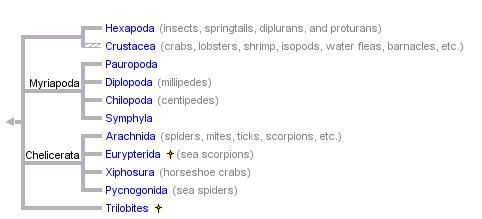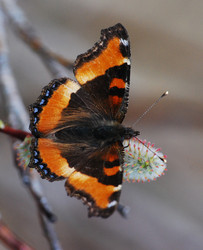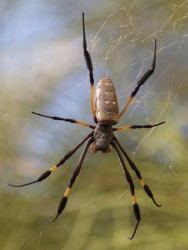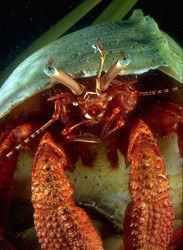Arthropoda



This tree diagram shows the relationships between several groups of organisms.
The root of the current tree connects the organisms featured in this tree to their containing group and the rest of the Tree of Life. The basal branching point in the tree represents the ancestor of the other groups in the tree. This ancestor diversified over time into several descendent subgroups, which are represented as internal nodes and terminal taxa to the right.

You can click on the root to travel down the Tree of Life all the way to the root of all Life, and you can click on the names of descendent subgroups to travel up the Tree of Life all the way to individual species.
For more information on ToL tree formatting, please see Interpreting the Tree or Classification. To learn more about phylogenetic trees, please visit our Phylogenetic Biology pages.
close boxSee the papers listed in the References section. This tree does not include most of the diverse extinct lineages of the early Paleozoic.
References
Akam, M. 2000. Arthropods: Developmental diversity within a (super) phylum. Proceedings of the National Academy of Sciences (USA) 97:4438-4441.
Averof, M. and M. Akam. 1995. Insect-crustacean relationships: Insights from comparative developmental and molecular studies. Philosophical Transactions of the Royal Society of London B Biological Sciences 347:293-303.
Averof, M. and M. Akam. 1995. Hox genes and the diversification of insect and crustacean body plans. Nature 376:420-423.
Ballard, J. W. O., O. Ballard, G. J. Olsen, D. P. Faith, W. A. Odgers, D. M. Rowell and P. Atkinson. 1992. Evidence from 12S ribosomal RNA sequences that onychophorans are modified arthropods. Science 258:1345-1348.
Bitsch, C. and J. Bitsch. 2004. Phylogenetic relationships of basal hexapods among the mandibulate arthropods: a cladistics analysis based on comparative morphological characters. Zoologica Scripta 33(6):511-550.
Blaxter, M. 2001. Evolutionary biology - Sum of the arthropod parts. Nature 413(6852):121-122.
Boore, J.L., T.M. Collins, D. Stanton, L.L Daehler, and W.M. Brown. 1995. Deducing the pattern of arthropod phylogeny from mitochondrial DNA rearrangements. Nature 376:163-165.
Boore, J.L., D. V. Lavrov, and W.M. Brown. 1998. Gene translocation links insects and crustaceans. Nature 392:667-668.
Briggs, D.E.G., and R.A. Fortey. 1989. The early radiation and relationships of the major arthropod groups. Science 246:241-243.
Briggs. D. E. G., R. A. Fortey and M. A. Wills. 1993. How big was the Cambrian explosion? A taxonomic and morphologic comparison of Cambrian and Recent arthropods. Pages 33-44 in Evolutionary Patterns and Processes (D. R. Lees and D. Edwards, eds.) Linnean Society Symposium, Linnean Society of London.
Brusca, R.C. 2000. Unraveling the history of arthropod diversification. Annals of the Missouri Botanical Garden 87:13-25.
Budd, G. E. 1996. The morphology of Opabinia regalis and the reconstruction of the arthropod stem-group. Lethaia 29:1-14.
Budd, G. E. 1996. Progress and problems in arthropod phylogeny. Trends in Ecology and Evolution 9:356-358.
Budd, G. E. 2002. A palaeontological solution to the arthropod head problem. Nature 417:271-275.
Cameron, S.L., K.B. Miller, C.A. D’Haese, M.F. Whiting, and S.C. Barker. 2004. Mitochondrial genome data alone are not enough to unambiguously resolve the relationships of Entognatha, Insecta and Crustacea sensu lato (Arthropoda). Cladistics 20:534–557.
Chen, J. C., L. Ramsköld, and G. Zhou. 1994. Evidence for monophyly and arthropod affinity of cambrian giant predators. Science 263:1304-1308.
Cook, C. E., M. L. Smith, M. J. Telford, A. Bastianello, and M. Akam. 2001. Hox genes and the phylogeny of the arthropods. Current Biology 11:759-763.
Cook, C. E., , Q. Yue, and M. Akam. 2005. Mitochondrial genomes suggest that hexapods and crustaceans are mutually paraphyletic. Proceedings of the Royal Society Series B 272(1569):1295-1304.
Dohle, W. 1997. Are the insects more closely related to the crustaceans than to the myriapods? Entomologia Scandinavica Suppl. 51:7-16.
Dunlop, J. A. and C. P. Arango. 2005. Pycnogonid affinities: a review. Journal of Zoological Systematics & Evolutionary Research 43(1):8-21.
Edgecombe, G. D. 1998. Devonian terrestrial arthropods from Gondwana. Nature 394:172-175.
Edgecombe, G. D. (ed.) 1998. Arthropod fossils and phylogeny. Columbia University Press, New York.
Edgecombe, G.D. and G. Giribet. 2002. Myriapod phylogeny and the relationships of Chilopoda. Pages 143-168 in: Biodiversidad, taxonomía y biogeografía de artrópodos de México: Hacia una síntesis de su conocimiento (J. Llorente Bousquets, J.J. Morrone & H. Ponce Ulloa, Eds.). Prensas de Ciencias, UNAM, Mexico.
Edgecombe, G. D. and L. Ramskold. 1999. Relationships of Cambrian Arachnata and the systematic position of Trilobita. Journal of Paleontology 73:263-287.
Edgecombe, G. D., G. D. F. Wilson, D. J. Colgan, M. R. Gray, and G. Cassis. 2000. Arthropod cladistics: Combined analysis of histone H3 and U2 snRNA sequences and morphology. Cladistics 16:155-203.
Fortey, R. A. and R. H. Thomas (eds.) 1998. Arthropod Relationships. Systematics Association Special Volume Series 55. Chapman & Hall, London.
Friedrich, M. and D. Tautz. 1995. Ribosomal DNA phylogeny of the major extant arthropod classes and the evolution of myriapods. Nature 376:165-167.
Friedrich, M. and D. Tautz. 2001. Arthropod rDNA phylogeny revisited: a consistency analysis using Monte Carlo simulations. Pages 21-40 in Origin of the Hexapoda. T. Deuve, ed. Annales de la Société entomologique de France 37.
Garcia-Machado, E., M. Pempera, N. Dennebouy, M. Oliva-Suarez, J. C. Mounolou, and M. Monnerot. 1999. Mitochondrial genes collectively suggest the paraphyly of crustacea with respect to insecta. Journal of Molecular Evolution 49:142-149.
Giribet G., G. D. Edgecombe, and W. C. Wheeler. 2001. Arthropod phylogeny based on eight molecular loci and morphology. Nature 413:157-161.
Giribet, G. and C. Ribera. 1998. The position of arthropods in the animal kingdom: A search for a reliable outgroup for internal arthropod phylogeny. Molecular Phylogenetics and Evolution 9:481-488.
Giribet G. and C. Ribera. 2000. A review of arthropod phylogeny: New data based on ribosomal DNA sequences and direct character optimization. Cladistics 16:204-231.
Hassanin, A. 2006. Phylogeny of Arthropoda inferred from mitochondrial sequences: Strategies for limiting the misleading effects of multiple changes in pattern and rates of substitution. Molecular Phylogenetics and Evolution 38(1):100-116.
Hwang, U. W., M. Friedrich, D. Tautz, C. J. Park, and W. Kim. 2001. Mitochondrial protein phylogeny joins myriapods with chelicerates. Nature 413:154-157.
Janzen, J.-W. 2002. Arthropods in Baltic Amber. Ampyx-Verlag, Halle (Saale).
Kusche, K. and T. Burmester. 2001. Diplopod hemocyanin sequence and the phylogenetic position of the Myriapoda. Molecular Biology and Evolution 18:1566-1573.
Lauterbach, K.E. 1988. The position of presumed Crustacea from the upper Cambrian in the phylogenetic system of the Mandibulata Arthropoda. Verhandlungen des Naturwissenschaftlichen Vereins Hamburg 30:409-468.
MacNaughton, R. B, J. M. Cole, R. W. Dalrymple, S. J. Braddy, D. E. G. Briggs, and T. D. Lukie. 2002. First steps on land: Arthropod trackways in Cambrian-Ordovician eolian sandstone, southeastern Ontario, Canada. Geology 30:391-394.
Mallatt, J., J. R. Garey, and J. W. Shultz. 2004. Ecdysozoan phylogeny and Bayesian inference: first use of nearly complete 28S and 18S rRNA gene sequences to classify the arthropods and their kin. Molecular Phylogenetics and Evolution (31)1:178-191.
Müller, K. J. and D. Walossek. 1985. A remarkable arthropod fauna from the Upper Cambrian "Orsten" of Sweden. Transactions Royal Society Edinburgh: Earth Sciences 76:161-172.
Negrisolo, E., A. Minelli, and G. Valle. 2004. The mitochondrial genome of the house centipede Scutigera and the monophyly versus paraphyly of myriapods. Molecular Biology and Evolution 21:770-780.
Osorio, D., M. Averof, and J. P. Bacon. 1995. Arthropod evolution: great brains, beautiful bodies. Trends in Ecology and Evolution 10:449-454.
Panganiban, G. A. Sebring, L. Nagy, and S. Carroll. 1995. The development of crustacean limbs and the evolution of arthropods. Science 270:1363-1366.
Paulus, H. F. 2000. Phylogeny of the Myriapoda-Crustacea-Insecta: a new attempt using photoreceptor structure. Journal of Zoological Systematics and Evolutionary Research 38:189-208.
Peel, A. D., A. D. Chipman, and M. Akam. 2005. Arthropod segmentation: Beyond the Drosophila paradigm. Nature Reviews Genetics 6(12):905-916.
Pisani, D., L.L. Polig, M. Lyons-Weiler, and S. B. Hedges. 2004. The colonization of land animals: molecular phylogeny and divergence times among arthropods. BMC Biol. 2(1).
Regier, J. C. and J. W. Shultz. 1997. Molecular phylogeny of the major arthropod groups indicates polyphyly of crustaceans and a new hypothesis for the origin of hexapods. Molecular Biology and Evolution 14:902-913.
Regier, J. C. and J. W. Shultz. 1998. Molecular phylogeny of arthropods and the significance of the Cambrian "explosion" for molecular systematics. American Zoologist 38:918-928.
Regier, J. C. and J. W. Shultz. 2001. A phylogenetic analysis of Myriapoda (Arthropoda) using two nuclear protein-encoding genes. Zoological Journal of the Linnean Society 132:469-486.
Regier, J. C. and J. W. Shultz. 2001. Elongation factor-2: A useful gene for arthropod phylogenetics. Molecular Phylogenetics and Evolution 20:136-148.
Regier, J. C., J. W. Shultz, and R. E. Kambic. 2005. Pancrustacean phylogeny: hexapods are terrestrial crustaceans and maxillopods are not monophyletic. Proceedings of the Royal Society Series B 272(1561):395-401.
Regier, J. C., J. W. Shultz, A. Zwick, A. Hussey, B. Ball, R. Wetzer, J. W. Martin, and C. W. Cunningham. 2010. Arthropod relationships revealed by phylogenomic analysis of nuclear protein-coding sequences. Nature. http://dx.doi.org/10.1038/nature08742
Regier, J. C., H. M. Wilson, and J. W. Shultz. 2005. Phylogenetic analysis of Myriapoda using three nuclear protein-coding genes. Molecular Phylogenetics and Evolution 34(1):147-158.
Richter, S. 2002. The Tetraconata concept: hexapod-crustacean relationships and the phylogeny of Crustacea. Organisms Diversity & Evolution 2:217-237.
Rota-Stabellia, O. and M. J. Telford. 2008. A multi criterion approach for the selection of optimal outgroups in phylogeny: Recovering some support for Mandibulata over Myriochelata using mitogenomics. Molecular Phylogenetics and Evolution 48(1):103-111.
Scholtz, G. 2001. Evolution of developmental patterns in arthropods - the analysis of gene expression and its bearing on morphology and phylogenetics. Zoology 103:99-111.
Schram, F. R. and R. A. Jenner. 2001. The origin of Hexapoda: a crustacean perspective. Pages 243-264 in Proceedings of the International Symposium on the Origin of the Hexapoda. T. Deuve, ed. Annales de la Société entomologique de France 37.
Shear, W. A. and J. Kukalová-Peck. 1990. The ecology of paleozoic terrestrial arthropods: the fossil evidence. Canadian Journal of Zoology 68:1807–1834.
Shultz, J. W. and J. C. Regier. 2000. Phylogenetic analysis of arthropods using two nuclear protein-coding genes supports a crustacean , hexapod clade. Proceedings of the Royal Society of London Series B 267:1011-1019.
Strausfeld N. J. 1998. Crusteacean-insect relationships: The use of brain characters to derive phylogeny amongst segmented invertebrates. Brain, Behavior and Evolution 52:186-206.
Stys, P., and J. Zrzavy. 1994. Phylogeny and classification of extant Arthropoda: Review of hypotheses and nomenclature. European Journal of Entomology 91:257-275.
Telford, M. J. and R. H. Thomas. 1995. Demise of the Atelocerata? Nature 376:123-124.
Timmermans, M. J. T. N., D. Roelofs, J. Marien, and N. M. van Straalen. 2008. Revealing pancrustacean relationships: Phylogenetic analysis of ribosomal protein genes places Collembola (springtails) in a monophyletic Hexapoda and reinforces the discrepancy between mitochondrial and nuclear DNA markers. BMC Evolutionary Biology 2008, 8:83. doi:10.1186/1471-2148-8-83
Waggoner, B. M. 1996. Phylogenetic Hypotheses of the Relationships of Arthropods to Precambrian and Cambrian Problematic Fossil Taxa. Systematic Biology 45:190-222.
Waloszek, D. and J. A. Dunlop. 2002. A larval sea spider (Arthropoda: Pycnogonida) from the Upper Cambrian 'Orsten' of Sweden, and the phylogenetic position of pycnogonids. Palaeontology 45:421-446.
Waloszek, D. and K. J. Müller. 1990. Upper Cambrian stem-lineage crustaceans and their bearing upon the monophyletic origin of Crustacea and the position of Agnostus. Lethaia 23:409-427.
Weygoldt, P. 1998. Evolution and systematics of the Chelicerata. Experimental and Applied Acarology 22:63-79.
Wheeler, W.C., P. Cartwright, and C.Y. Hayashi. 1993. Arthropod phylogeny: A combined approach. Cladistics 9:1-39.
Wheeler, W.C. and C.Y. Hayashi. 1998. The phylogeny of the extant chelicerate orders. Cladistics 14:173-192.
Zrzavy, J. and P. Stys. 1997. The basic body plan of arthropods: Insights from evolutionary morphology and developmental biology. Journal of Evolutionary Biology 10:353-367.
Information on the Internet
- Deep Arthropod Phylogeny Project
- Introduction to the Arthropoda. UCMP Berkeley.
- The Arthropod Story. From the Understanding Evolution web site.
- BugGuide.Net. An online community of naturalists who enjoy learning about and sharing observations of insects, spiders, and other related creatures.
- Insect and Spider Collections of the World.
- International Society of Myriapodology and Onychophorology.
- Hawaiian Terrestrial Arthropod Bibliography.
- Project ALAS: Arthropods of La Selva.
- Biological Survey of Canada: Terrestrial Arthropods.
- A Pictographic Key to Leaf Litter Arthropods from the Missouri Ozark Forest Ecosystem Project (MOFEP).
- Sonoran Arthropod Studies Institute.
- Arthropod Trackways. University of Bristol Earth Sciences Department.
- Arthropods in Baltic Amber. Jens-Wilhelm Janzen.
- C.O.R.E.: Research on the 'Orsten' and 'Orsten'-Type Fossils.
- Images: Insects and Their Relatives. Department of Entomology, University of Nebraska-Lincoln.
Title Illustrations

| Location | Cochrane, Alberta, Canada |
|---|---|
| Specimen Condition | Live Specimen |
| Source | Posing |
| Source Collection | Flickr |
| Image Use |
 This media file is licensed under the Creative Commons Attribution-NonCommercial License - Version 2.0. This media file is licensed under the Creative Commons Attribution-NonCommercial License - Version 2.0.
|
| Copyright | © 2007 Brad Smith |
| Scientific Name | Scutigera coleoptrata |
|---|---|
| Source | house centipede |
| Source Collection | Flickr |
| Image Use |
 This media file is licensed under the Creative Commons Attribution-NonCommercial-NoDerivs License - Version 2.0. This media file is licensed under the Creative Commons Attribution-NonCommercial-NoDerivs License - Version 2.0.
|
| Copyright | © 2004 kim fleming |
| Scientific Name | Nephila senegalensis |
|---|---|
| Location | Dakar, Senegal |
| Specimen Condition | Live Specimen |
| Source | Long-jawed Orb Weaver (Nephila senegalensis) |
| Source Collection | Flickr |
| Image Use |
 This media file is licensed under the Creative Commons Attribution-NonCommercial-ShareAlike License - Version 2.0. This media file is licensed under the Creative Commons Attribution-NonCommercial-ShareAlike License - Version 2.0.
|
| Copyright | © 2006 Thom Haslam |
| Scientific Name | Petrochirus diogenes |
|---|---|
| Location | from Gulf of Mexico, captive at Texas State Aquarium |
| Comments | giant red hermit crab |
| Specimen Condition | Live Specimen |
| Copyright |
© Greg and Marybeth Dimijian

|
About This Page
Page copyright © 1995
 Page: Tree of Life
Arthropoda.
The TEXT of this page is licensed under the
Creative Commons Attribution-NonCommercial License - Version 3.0. Note that images and other media
featured on this page are each governed by their own license, and they may or may not be available
for reuse. Click on an image or a media link to access the media data window, which provides the
relevant licensing information. For the general terms and conditions of ToL material reuse and
redistribution, please see the Tree of Life Copyright
Policies.
Page: Tree of Life
Arthropoda.
The TEXT of this page is licensed under the
Creative Commons Attribution-NonCommercial License - Version 3.0. Note that images and other media
featured on this page are each governed by their own license, and they may or may not be available
for reuse. Click on an image or a media link to access the media data window, which provides the
relevant licensing information. For the general terms and conditions of ToL material reuse and
redistribution, please see the Tree of Life Copyright
Policies.
Citing this page:
Tree of Life Web Project. 1995. Arthropoda. Version 01 January 1995 (temporary). http://tolweb.org/Arthropoda/2469/1995.01.01 in The Tree of Life Web Project, http://tolweb.org/













 Go to quick links
Go to quick search
Go to navigation for this section of the ToL site
Go to detailed links for the ToL site
Go to quick links
Go to quick search
Go to navigation for this section of the ToL site
Go to detailed links for the ToL site